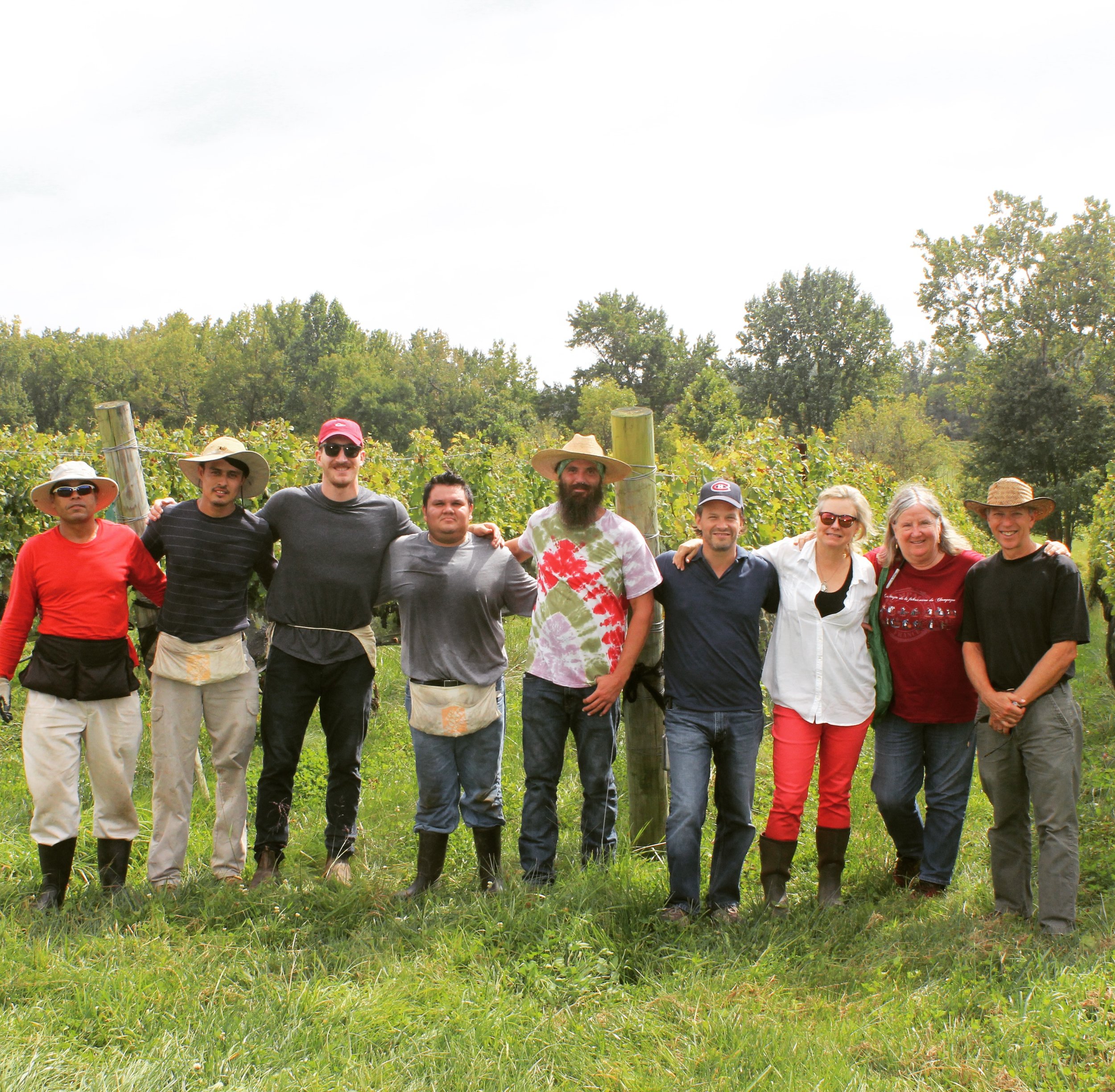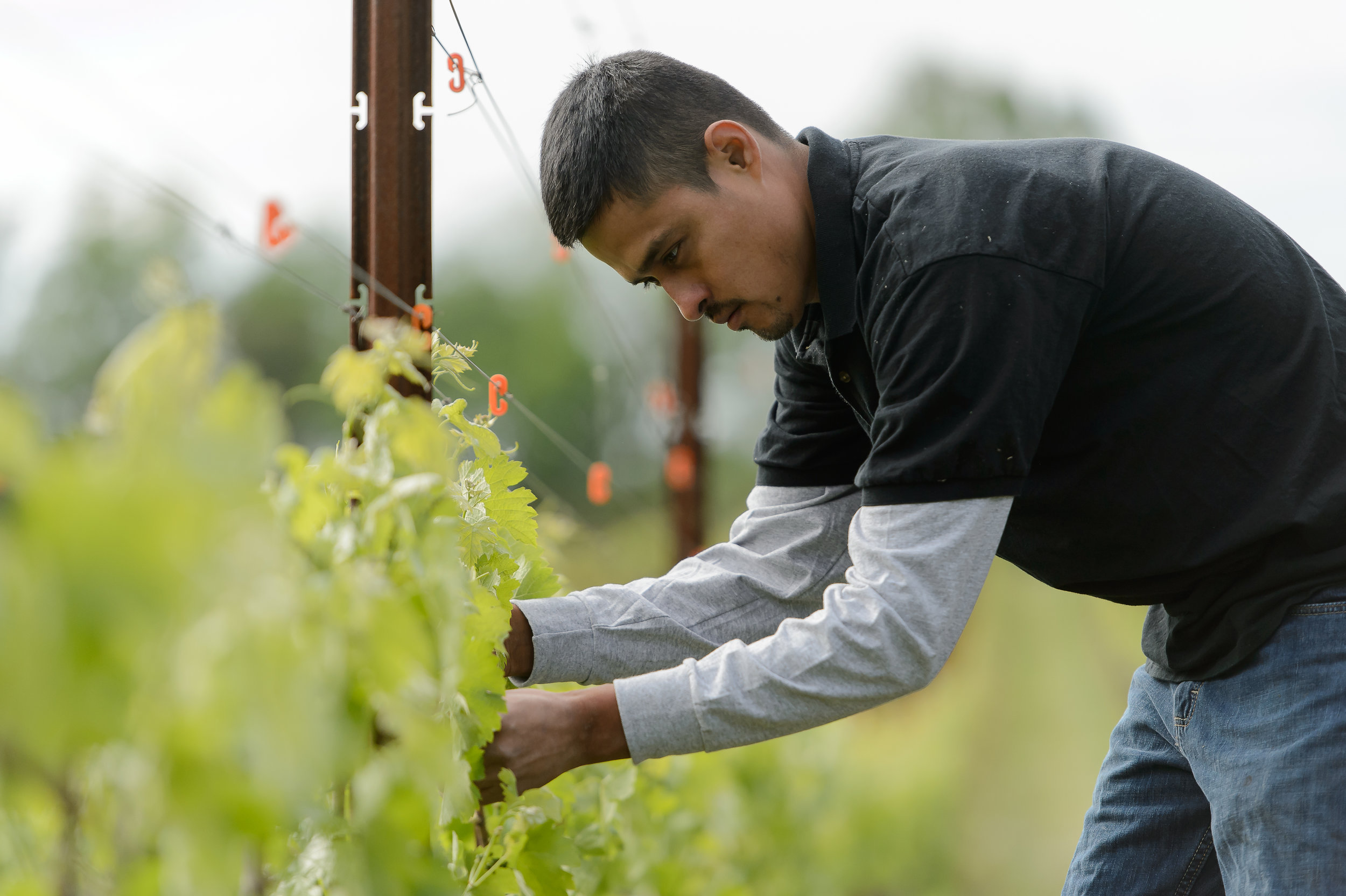As I reflect from the comfort of an air-conditioned office, the vineyard team is hedging for the third time this year. Usually, we only hedge twice, but the excess foliage that resulted from last year’s heavy rainfall is creating too much shade. The temperature will soon be 90 degrees Fahrenheit for the 27th time this season. The high humidity, now 97% according to the weather station, means that neither the vines nor those who tend them get much benefit from evaporative cooling.
The Dodon vineyard team stacks lugs of Chardonnay for transport to the winery for pressing.
Such moments of contemplation leave me eternally grateful for our vineyard team. They are dedicated to the hard work and perspiration that enhances the environment and produces the best wine. And they are part of a larger group of food and agricultural professionals who feed the nation. We owe them a great deal.
It takes considerable effort by many people in a complex system to get food on your table. Think for a moment about where your next meal will come from. If your answer is the supermarket, you’ve missed something.
Farm workers till soil, plant seeds, apply soil amendments, weed and water, raise honeybees, mow fields, feed animals and remove their waste, milk, gather eggs, pick vegetables and fruit, and clean equipment.
If your meal includes meat, meat packers slaughter, butcher, and wrap. Throughout the food system, a complex network of packers, forklift operators, and truck drivers distribute food from farm to market. Food service workers purchase ingredients; set tables; prepare, cook, plate, and serve meals; bus plates; and wash dishes and put them away.
Collectively, food workers make up 9% of the American workforce. These are people who should have the training and experience to carry out their function efficiently and effectively and to ensure that food is safely delivered to your table. And they should be able to advance in their careers, support their families, and pursue their interests.
And yet, despite the importance of the work that they perform, food workers at every level of the system are, as often as not, inadequately paid, treated, and trained to perform their jobs effectively. Farm work ranks among the 25 lowest paid occupations in America. Food service occupations - cooks, servers, bus people, and dishwashers – are in the bottom 10. And because these workers are often women and immigrants with fewer legal protections than other workers, they are frequently abused and exploited.
In his powerful book Fast Food Nation, Eric Schlosser tells the story of the erosion of meat packing as an occupation. According to Schlosser, meat packers in 1970 were considered skilled workers who enjoyed middle class wages and long-term employment. Now, according to the Occupational Safety and Health Administration, meat packing has become the most dangerous occupation in America, with largely unskilled workers using hand-held knives to process meat at rates twice those of other countries.
Moreover, surveys find that more than a third of all women in the food service sector, especially those making minimum wage (currently $3.63 per hour for tipped workers in Maryland), have experienced some form of unwanted sexual harassment, making this the single largest source of sexual harassment claims reported to the Equal Employment Opportunity Commission.
The current system may keep food prices low, but I wonder about its true costs. Given the abuse, low wages, and degree of manual labor, Enlightenment Now author Steven Pinker wonders why anyone would want to be a farm worker, suggesting that vertical farming and synthetic food offer better alternatives. (There may even be synthetic wine in the future.)
Technology-based solutions may have a role in the future of our food system, but whether food is grown in soil, laboratories, or factories, its increasing complexity will require skilled workers. These are, after all, the people who feed us. Much as we should value the work of teachers, nurses, and public safety officers, we should appreciate the passion, dedication, knowledge, and ownership that farm and other food workers bring to their jobs.
Tom teaches the team how to scout for fungal disease.
Education is one way to recognize the skilled nature of food work. For example, while most small farms make significant effort to train their workers, plentiful off-farm opportunities for basic training in soil science, horticulture and plant pathology, entomology, pesticide safety and stewardship, mechanics, and other subjects would both acknowledge the importance of workers and enhance their value.
Maryland’s seventeen community colleges have the infrastructure to provide this education, but of these, only Chesapeake College in Wye Mills, offers an agriculture track. Paid apprenticeships, such as those supported by the Department of Labor, also offer important opportunities for training. Unfortunately, these are currently ill-defined, making them difficult for farmers to access.
The Governor’s Workforce Development Board, along with its twelve local partners, has the responsibility to assess workforce needs in the state and to create policies and programs to address them. Agriculture should become a priority for the Board.
As the climate warms, farm worker training and education will likely pay larger, societal dividends. When the appropriate methods are used, agriculture represents an important way to sequester carbon and address climate change. Skilled, educated workers will implement these methods and adapt them to local conditions more effectively than those that aren’t adequately trained.
In addition to technical training, farm and food work, like many other skilled occupations, also requires soft skills, such careful observation, attention to detail, critical thinking, and problem-solving, activities that are best done when workers are close to the product and those who consume it. And the workers deserve ongoing career pathways so that these are not seen as “dead-end” jobs to be avoided when, like now, alternatives are plentiful.
And simply recognizing the contributions of workers throughout the food system is the most important way we have to say thanks for a job well-done.




